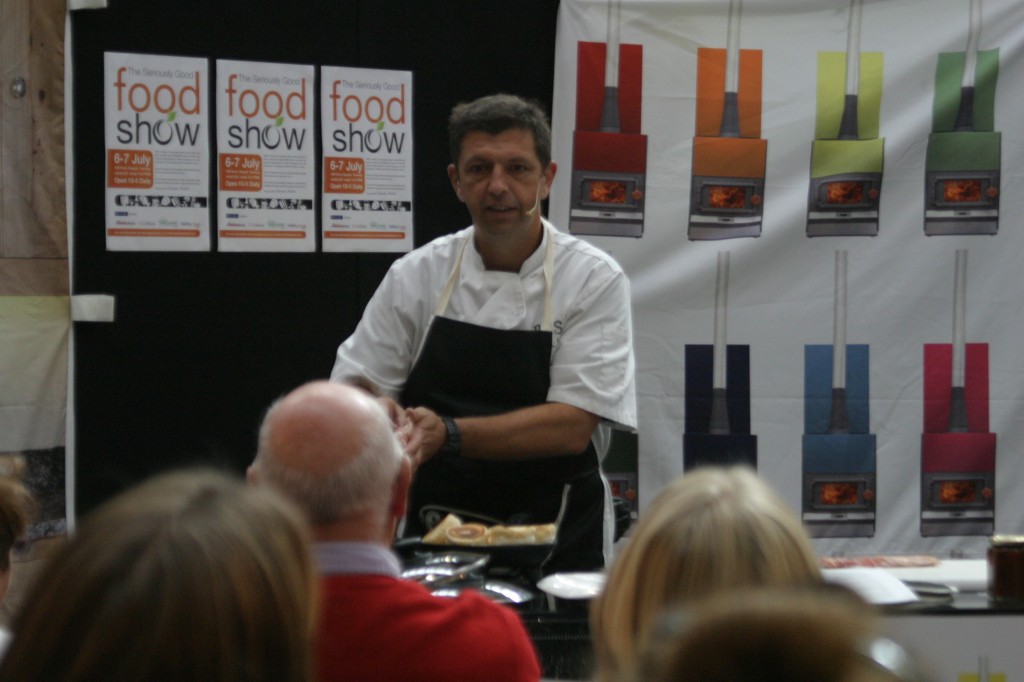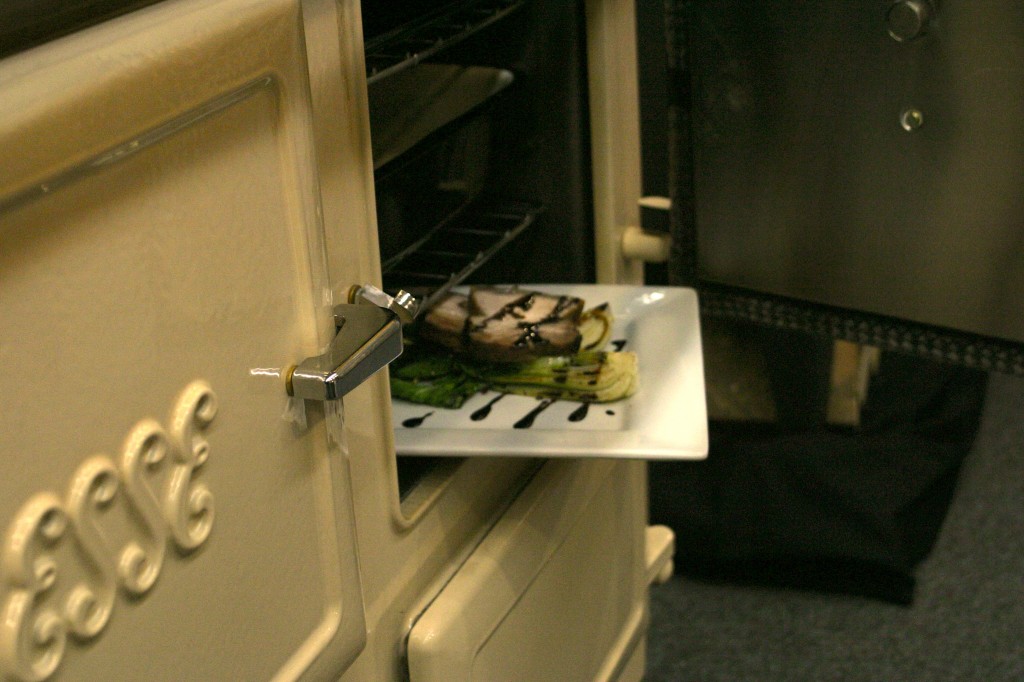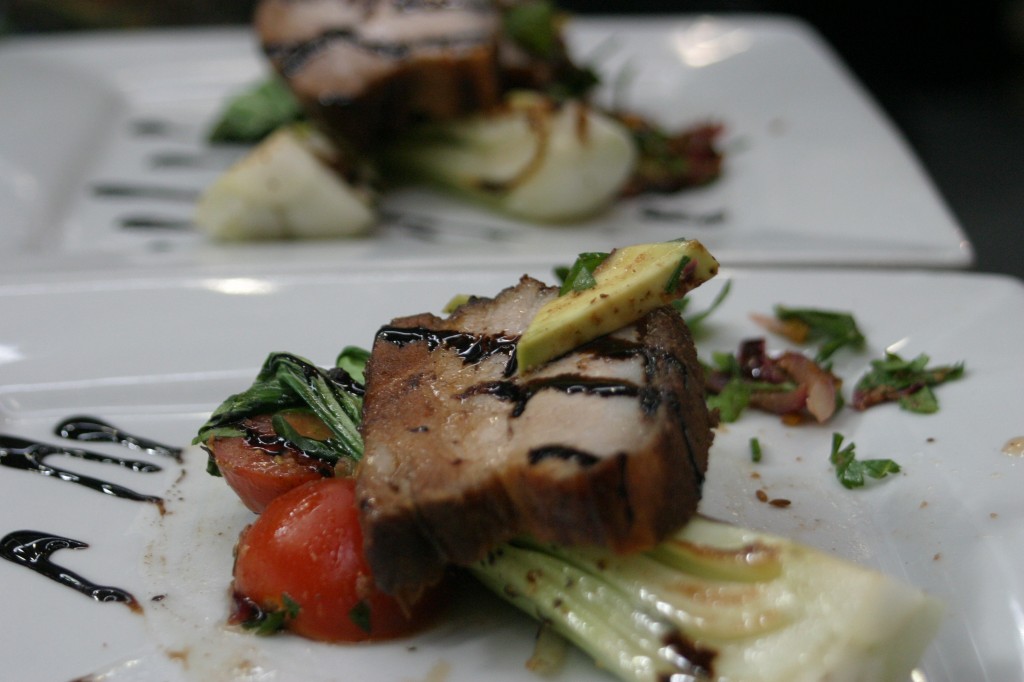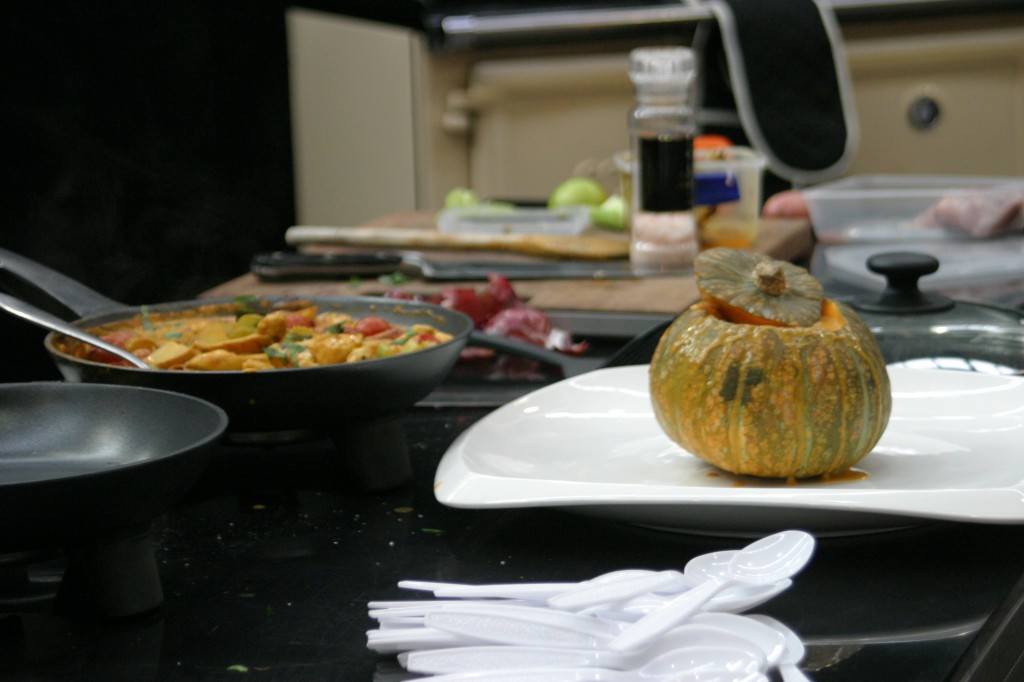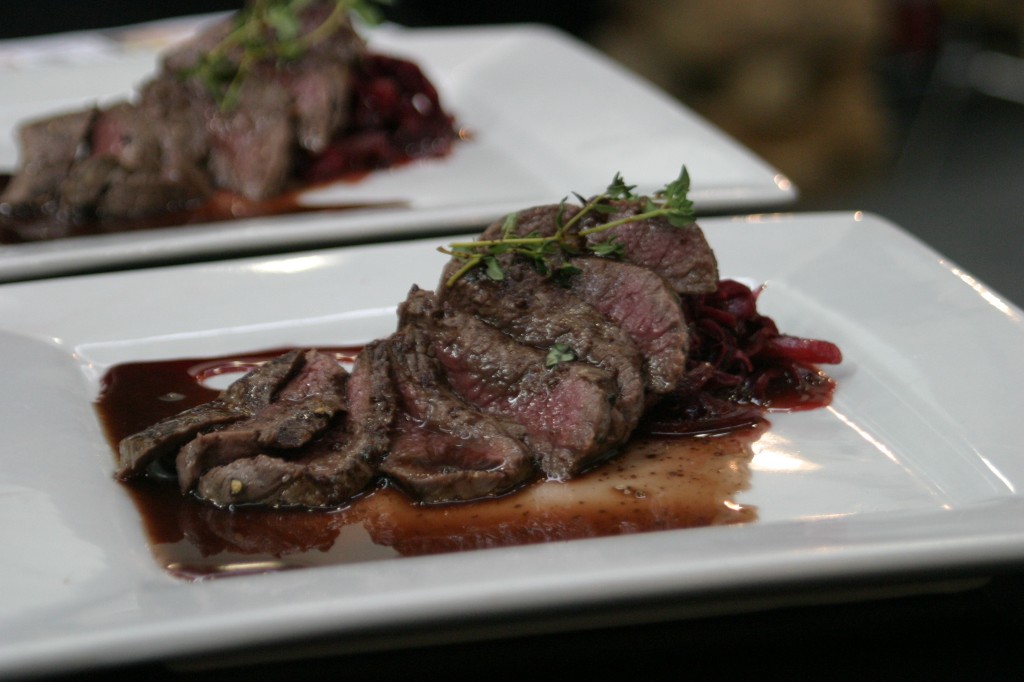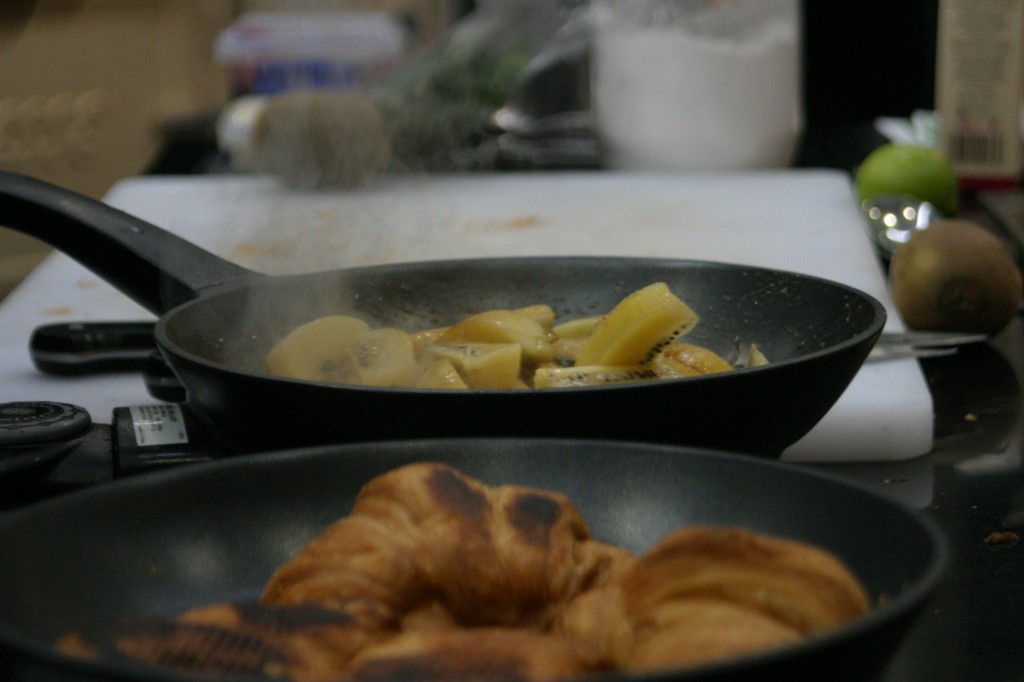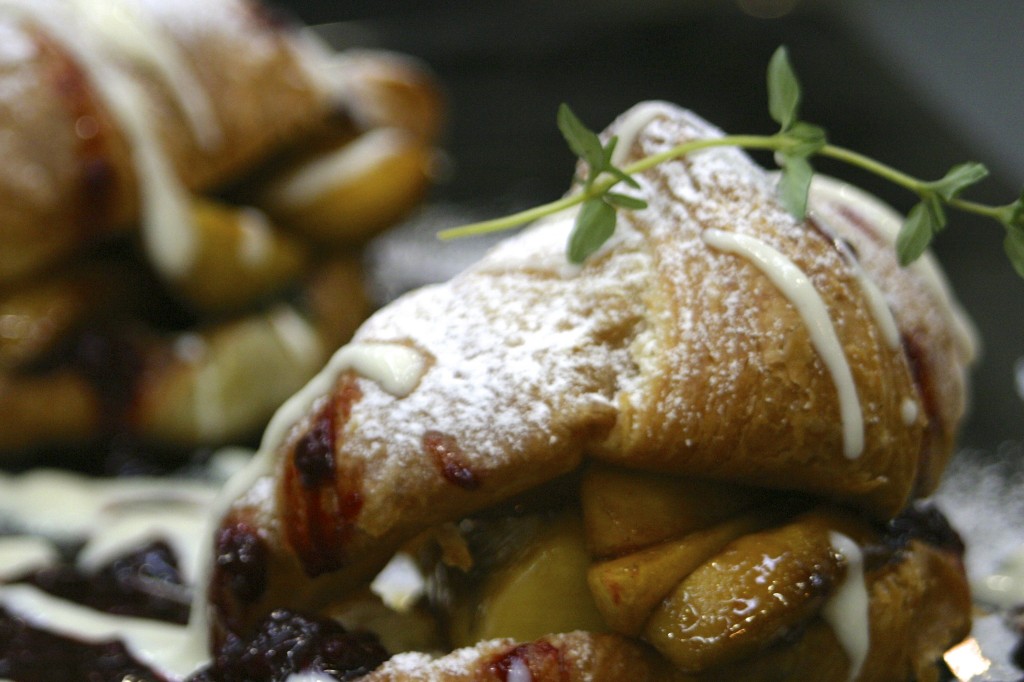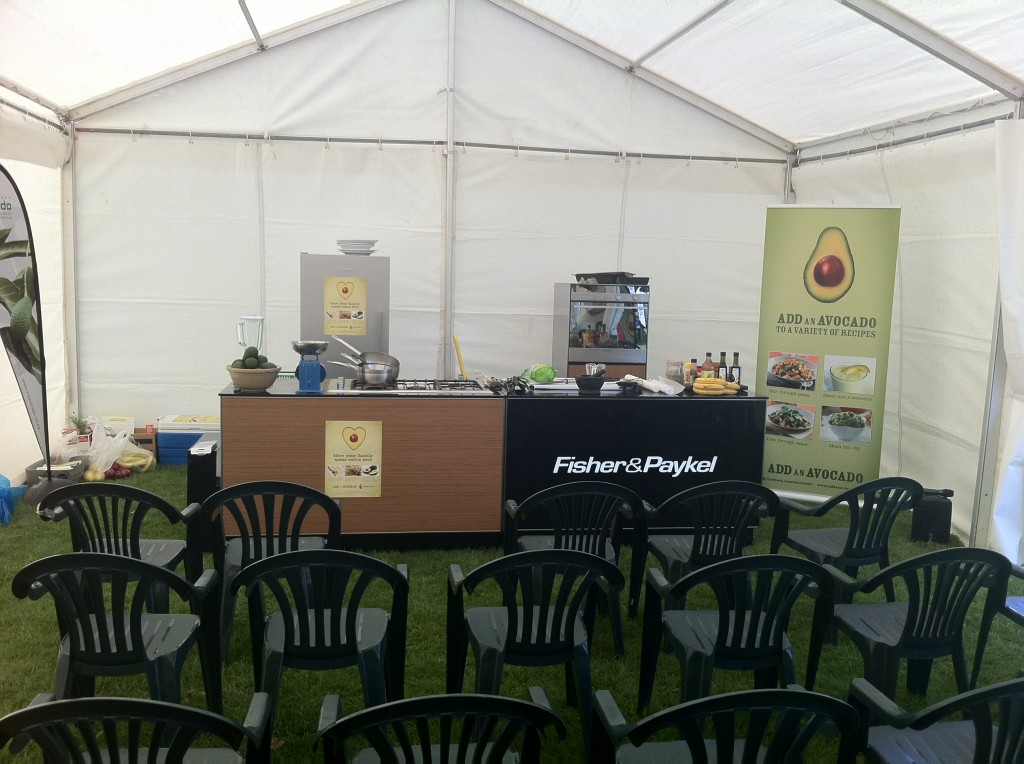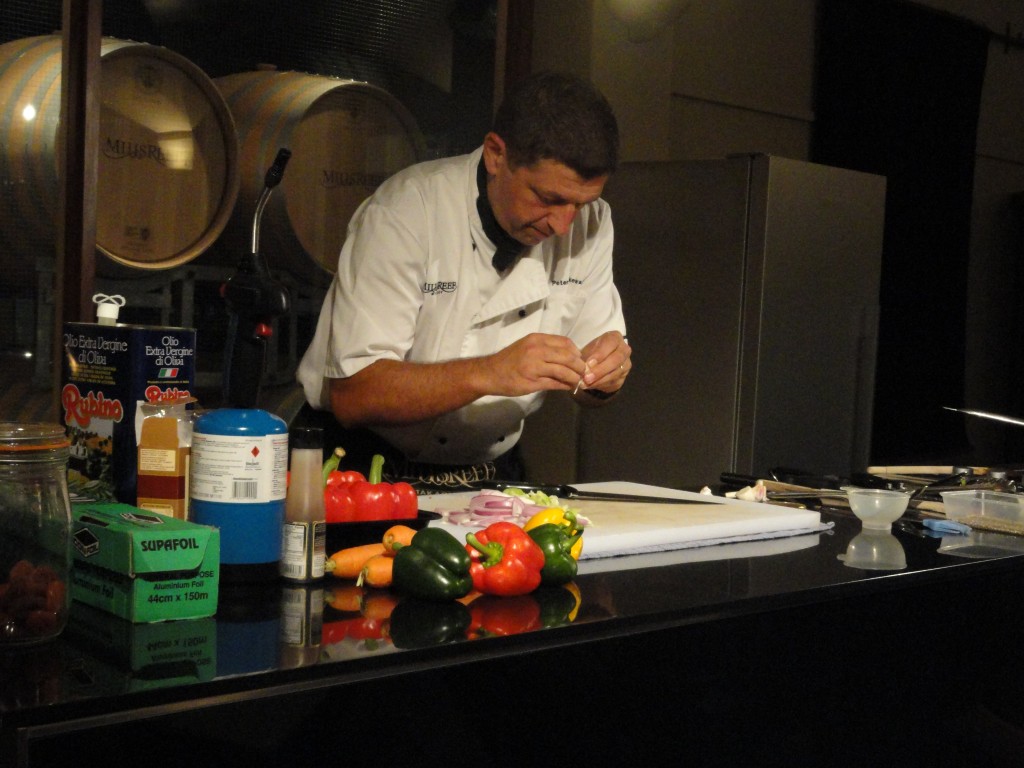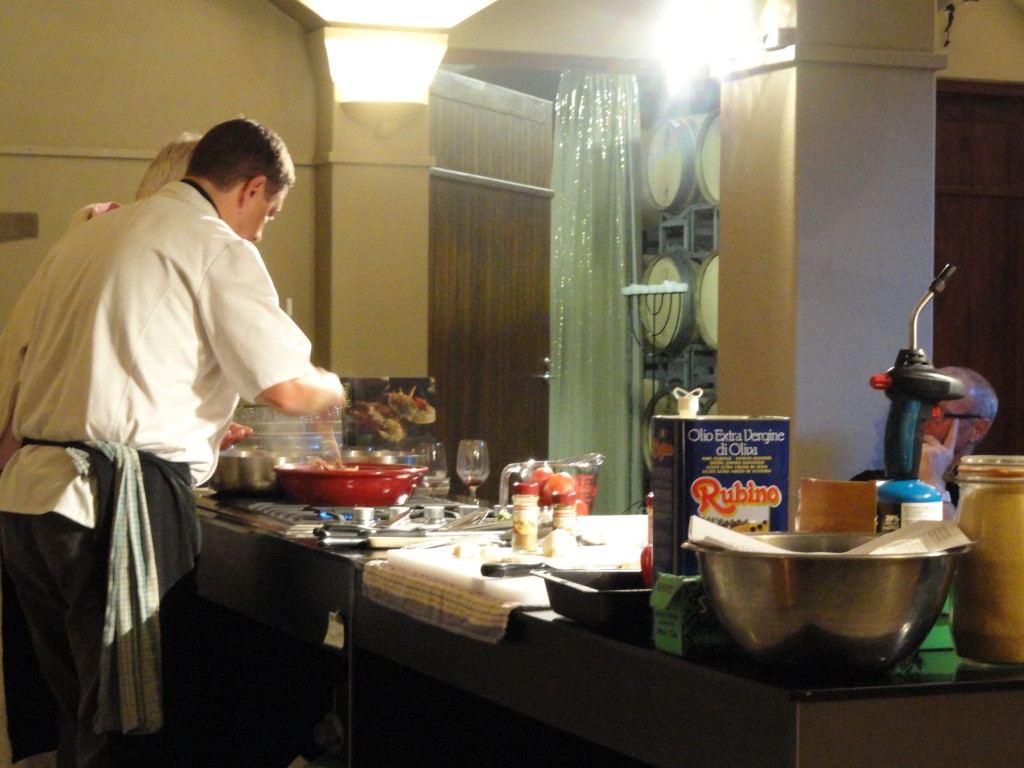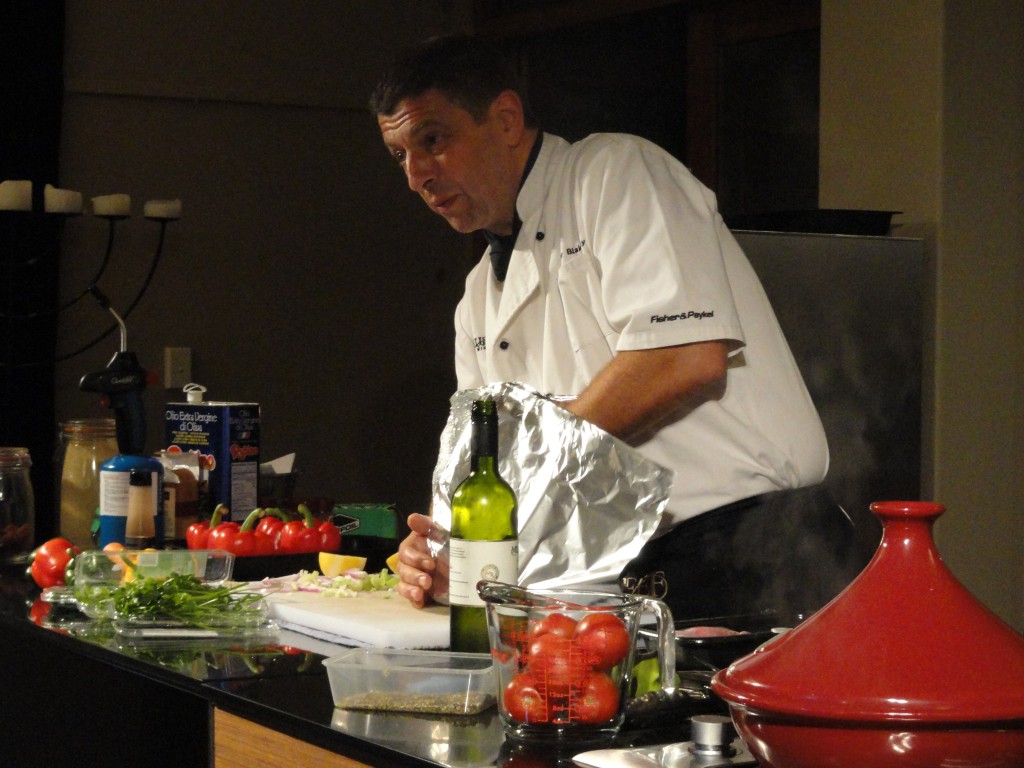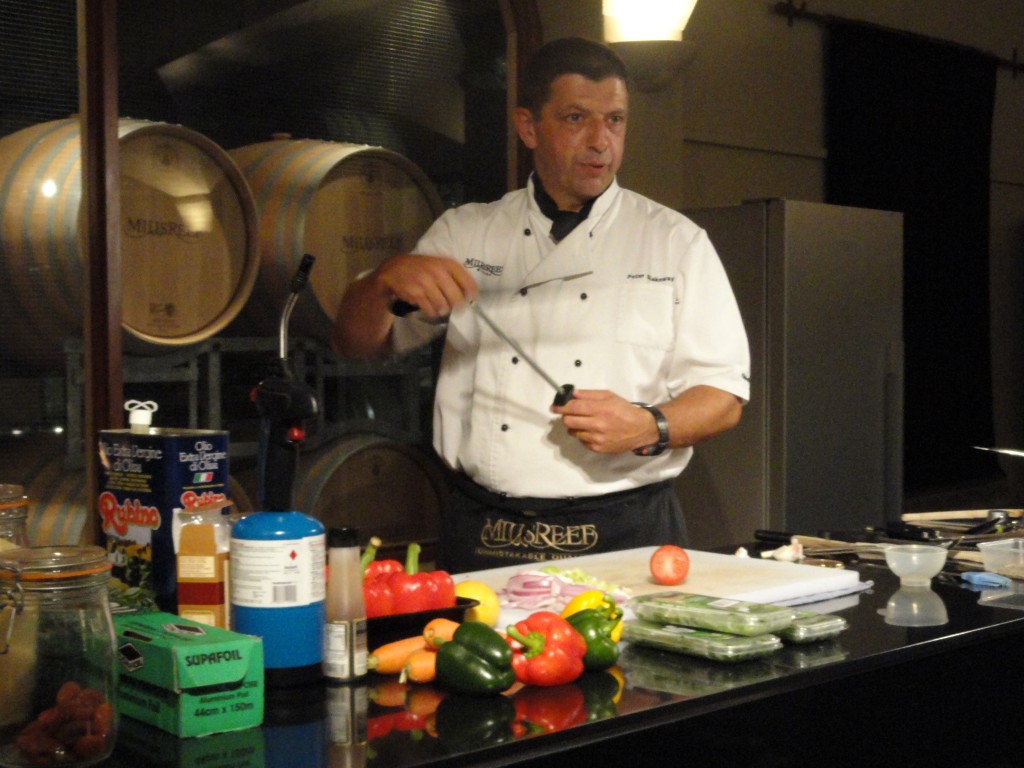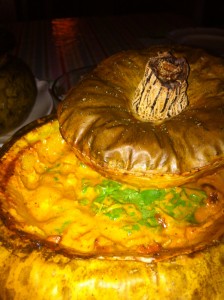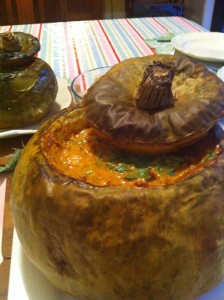It has been a great first day at the home show here are the recipes
Chinese Crisp Roasted Pork
1 x 1kg piece fresh belly pork, boned but not skinned
2 cloves garlic, finely chopped
1 tablespoon light soy sauce
3 teaspoons salt
½ teaspoon five-spice powder
Method
Score pork skin at 1cm intervals, using a very sharp knife and cutting right through the skin. Blanch meat in a large sauce pan of boiling water for 2 minutes, then lift out, rinse under cold water and dry well with kitchen paper. Combine garlic and soy sauce and rub all over meat side of pork. Combine salt and five-spice powder and rub all over skin. Refrigerate uncovered, skin-side up, for at least 2 hours or overnight.
Preheat oven to 230°C and line a baking dish with foil. Position a rack in baking dish and settle pork on rack, skin-side up. Bake for 20 minutes, then reduce oven temperature to 200°C and bake for 40 minutes or until skin crackles and crisps.
Cool a little before cutting into slices and then into thick fingers. Serve hot with steamed rice and Asian greens or at room temperature as an entrée with a dish of hoi sin sauce for dipping, or use in a stir-fry.
Gravadlax
There are as many recipes for this as there are spellings for it throughout Scandinavia – this one happens to be from a Danish friend. It is a fantastic alternative to smoked salmon with a fresh and subtle flavour.
Serves 10
1 whole side fresh salmon
2 heaped tablespoons sea salt
2 rounded tablespoons granulated sugar
2 teaspoons crushed black pepper
2 tablespoons spirit alcohol ( I use vodka, but be creative)
2 rounded tablespoons fresh dill
- Mix together salt, sugar, pepper, alcohol and dill.
- Spread the mixture over the salmon.
- wrap with gladwrap and then tin foil.
- Weigh down with a couple of tins and refrigerate, turning daily, for up to 5 days. You’ll notice a liquid seep out of the fish, don’t worry that is just the water coming out and can be discarded each day.
- Serve as a canapé, starter or for the truly enlightened with scrambled eggs on Mothering Sunday.
Truffled Poached Chicken
The unbelievable aromas when this dish is cooking are to die for! If you’re selling your house, forget fresh roasted coffee and baking bread – the smell when this is cooking will have them queuing out of the door! Truffles can be very expensive but will transform an everyday dish into something truly extraordinary. You only live once after all!
1.35kg free range chicken
2 medium carrots, peeled
2 sticks celery, sliced
1 onion, skin on but topped and tailed
4 medium leeks, washed and cut into 2.5cm slices
115g unsalted butter
bouquet garni of parsley stalks, 8 black peppercorns and a sprig of thyme, tied in muslin
2.25 litres chicken stock or water
1 black truffle (about 50g)
salt and pepper
- Gently scrub the truffle, peel it (reserving the trimmings) and slice very thinly.
- Slip the truffle slices under the skin of the chicken evenly on both sides, ensuring some slices are also under the leg skin.
- Place the chicken into a large pan with all the vegetables (except the leeks), bouquet garni and chicken stock and bring to the boil.
- Turn down heat, season with salt and pepper and simmer uncovered for 60 minutes.
- Remove chicken, drain and keep in a warm place.
- Sieve the stock and return to a clean saucepan on a high heat.
- As it comes to the boil, skim the ‘scum’ that forms on the surface and continue to boil for 5 to 10 minutes.
- Meanwhile, blanch the leeks in a pan of rapidly boiling water for 3 minutes and drain.
- Chop the truffle peelings finely and mash together in a bowl with the softened butter, salt and pepper.
- Melt the truffled butter in a fry pan over a medium heat, add the leeks and cook gently until hot.
- Serve the broth first in soup plates, followed by the warm chicken and leeks.
Braised Beef Cheeks
2 beef cheeks
300ml hearty red wine
1/2-1 tsp Chinese five spice
2 tbsp butter or even better, duck fat
salt and pepper to taste
2 cloves garlic, sliced very thinly
1. In a very hot heavy pan (cast iron would be the best option), sear the cheeks on both sides for approximately 1-2 minutes per side. Remove from pan and set in a slow cooker.
2. Pour the wine over top, sprinkle the cheeks liberally with Chinese five spice, toss in the butter (or duck fat), season to taste with salt and sprinkle the garlic over top.
3. Set the slow cooker to “low” and allow to cook uninterrupted for 8 hours.
4. When finished, remove from slow cooker gently (as they will be delicate and fall apart easily at this stage, and serve with accompanying vegetables or mashed potatoes.
Dauphinoise Potatoes
Serves 5 – 6
1 kg waxy potatoes, peeled and thinly sliced
1 large clove garlic, crushed
250ml milk
250ml cream
25g parmesan
Seasoning
Method
Bring the liquids to the boil with the garlic and add the potatoes. Simmer until potatoes are tender and liquid has thickened with the potato starch, stirring very gently a couple of times. Turn the potatoes out onto a buttered ovenproof dish. Grate the parmesan on top and bake in a preheated oven at 150˚C for approximately 1 hour or until golden brown on top. Can be used straight away or refrigerated and re-heated.
Saffron and Earl Grey Poached Pears
Pears hold their shape really well, as long as you don’t allow the liquor to boil once the pears have been added.
Serves 4
4 pears
1 split vanilla pod
1/2 bottle White wine
120g sugar
Pinch of Saffron
Earl Grey Tea Bag
zest and juice of 1/2 orange
a bunch of fresh thyme
125g butter
- Add all except the butter and the pears to a small casserole pan, bring to
the boil turn down to a gentle simmer and add the pears. Simmer for about 1 hour or until tender.
- Remove the pears and reduce the liquid by half.
- Away from the heat, add the butter and agitate for a while.
- Put the pears back in and leave until ready to serve.
- Warm is the best temperature to serve this dish.
Eggs Benedict with Smoked Salmon
Serves 2
2 English muffins
4 pieces ‘Aoraki’ smoked salmon
4 poached eggs (see below)
4 tablespoons ‘Quick Blender Hollandaise’ sauce (see below)
Method
Split each muffin, toast and butter. Cover each half with smoked salmon. Top with a poached egg and a good dollop of hollandaise sauce.
Perfect Poached Eggs
Serves 1
2 very fresh, free-range eggs
Plenty of boiling water
Method
Fill a large pan with water and bring to just below boiling. Use a spoon to get the water moving in a gentle circle and break the eggs in. Keep swirling the water gently while cooking the eggs – it may take up to 10 minutes. Do not rush the process; otherwise the white will separate from the egg.
To check if the egg is cooked, lift gently with a slotted spoon and check that none of the white is still transparent; it should be fairly solid and plump around the yolk.
Quick Blender Hollandaise
Makes 600ml
175g butter
2 tablespoons wine vinegar
4 tablespoons lemon juice
6 large egg yolks
A large pinch of salt
6 rounded tablespoons fresh chives, snipped
Method
Melt butter slowly in a small saucepan. Place wine vinegar and lemon juice in another pan and bring to the boil. Meanwhile blend egg yolks in a food processor or liquidiser, then – with the motor still running – gradually add the hot lemon and vinegar. When the butter reaches the boil, trickle this in very slowly, with motor still running until it is all added and the sauce is thickened. Stir in snipped chives. Serve immediately with barbequed salmon or vegetables, e.g. asparagus. Will also keep for up to 2 days if covered with glad wrap and refrigerated.
English Muffins
Makes 8
400g Hi-Tec white flour
1 tsp salt
25g butter
225ml milk
2 tsp dried yeast
1 egg
Butter or oil for frying
Method
Sift flour and salt into large bowl and rub in butter. Warm milk gently in a saucepan to blood heat, then sprinkle dried yeast on top and leave for 10 – 15 minutes until frothy. Beat in the egg. Add yeast liquid to the flour to make a very soft dough. Beat by hand or with a wooden spoon for about 5 minutes, until smooth and shiny. Cover with a large, lightly oiled plastic bag and leave in a warm place for 1 – 2 hours, or until doubled in size.
Knead again lightly and roll out onto a well floured surface to a thickness of about 1 cm. Cut into rounds and place on a floured baking sheet. Cover with plastic bag and leave to rise for about 45 minutes or until light and puffy. Heat oil or butter on a hot plate or heavy bottom frypan. Cook muffins for about 4 minutes on each side until golden.
Chinese Crisp Roasted Pork WITH BOK CHOY, PICKLED TOMATOES AND AVOCADO
1 x 1kg piece fresh belly pork, boned but not skinned
2 cloves garlic, finely chopped
1 tablespoon light soy sauce
3 teaspoons salt
- ½ teaspoon five-spice powder
- 2 cups cherry tomatoes
- 3 Tbsp. avocado oil
- 2 shallots, minced
- 2 jalapeños, sliced thinly
- ½ tsp. cumin seed, toasted and ground
- 1 tsp. mustard seeds, toasted and ground to a paste
- 4 Tbsp. lime juice, freshly squeezed
- 3 Tbsp. cider vinegar
- 1 Tbsp. brown sugar
- ¼ cup chopped mint
- ¼ cup chopped parsley
- 1 tsp. plus a pinch r salt
- 3 ripe, Fresh Avocados
- 1 tsp. vegetable oil
- 3 cups cleaned and thinly chopped bok choy
Method
Score pork skin at 1cm intervals, using a very sharp knife and cutting right through the skin. Blanch meat in a large sauce pan of boiling water for 2 minutes, then lift out, rinse under cold water and dry well with kitchen paper. Combine garlic and soy sauce and rub all over meat side of pork. Combine salt and five-spice powder and rub all over skin. Refrigerate uncovered, skin-side up, for at least 2 hours or overnight.
Preheat oven to 230°C and line a baking dish with foil. Position a rack in baking dish and settle pork on rack, skin-side up. Bake for 20 minutes, then reduce oven temperature to 200°C and bake for 40 minutes or until skin crackles and crisps.
Place the tomatoes in a glass or ceramic bowl that can withstand a little heat. Season the tomatoes with the salt.
In a large fry pan bring olive oil to a simmer over medium high heat, just below smoke point. Add shallot and then jalapeños. Fry off until tender, about two minutes and then add the cumin and the mustard seeds. Toast for about a minute and remove from heat.
Let cool slightly and then carefully add half of the lime juice and vinegar and then pour this over seasoned tomatoes. Add mint, parsley and about ½. of the kosher salt. Let the tomatoes sit at room temperature for the flavors to mature. While the pan is still hot add the bok choy and let it wilt in the pan, adding a pinch of salt to season
Cool a little before cutting into slices and then into thick fingers. Serve hot or at room temperature as an entrée with a dish of hoi sin sauce for dipping, or use in a stir-fry.
Baked Pumpkin
Ingredients
Serves 8
1 pumpkin, washed and scrubbed (about 5kg)
olive oil
1kg chicken, trimmed and large diced (about 2cm)
3 cloves garlic, crushed
2 onions, chopped
2 small green peppers, sliced
1 large celery stalk, chopped
1 green chilli, finely chopped
300 ml coconut cream
300 ml puréed tomatoes
1 tablespoon korma paste
Bouquet garni
3 tomatoes, skinned deseeded and chopped
3 potatoes, peeled and diced
corriander
Method
Preheat oven to 180˚C
Choose a pumpkin with a decent stem on it as this will serve as a handle in the lid. Cut the top off the pumpkin to form a lid and scoop all the seeds and stringy bits out. Put the lid back on and bake for 1 – 1½ hours or until tender but still firm. Once cooked scoop a little more of the flesh out to give enough space for the casserole being careful not to damage the outer layer and skin.
Meanwhile heat a few tablespoons of olive oil in a large pan and brown the chicken on all sides. Remove and set aside. In the same pan, adding more oil if necessary, fry off the onions, garlic, celery, capsicum, potatoes and chilli until soft. Add the korma paste and fry to release flavours. Pour in the tomato and coconut and bring to a simmer. Return the meat to the pan, add the tomatoes, bouquet garni and seasoning to taste, cover and cook gently for 20 minutes.
Spoon the casserole into the pumpkin and bake in the oven for a further 20 minutes.
Carefully place the pumpkin on a serving dish and fish out the bouquet garmi before serving.
Venison Loin with Chocolate Sauce and Spiced Red Cabbage
Venison is one of those rich gamey flavours that can handle a bit of creativity in the accompanying sauce. It works well with berry fruits or in this case, high quality chocolate.
Serves 4
1 backstrap (loin or saddle) venison
“Mire-poix” of root vegetables, e.g. carrot, onion, leek, garlic, peeled and chopped into small dice
15 ml groundnut oil
1 cup red wine
1 cup Ruby Port
1 litre game stock (or beef stock)
2 pistules bittersweet chocolate (70% cocoa solids)
Spiced Red Cabbage
Serves 4–6
900g firm red cabbage
450g Granny Smith apples
225g onions
110g butter
2 garlic cloves
1/4 teaspoon each of powdered nutmeg, allspice, cinnamon, thyme and caraway seeds
275ml red wine
2 tbsp red wine vinegar
2 tbsp brown sugar
100g sultanas or raisins
Juice and grated rind of 2 oranges
Seasoning
- Shred the cabbage finely and toss in the melted butter. In a suitable casserole dish, layer the cabbage, apple, onion and orange rind. Sprinkle each layer with salt, pepper and sugar. Pour over liquidised red wine, vinegar, orange juice and spices. Cover and bake at 190˚C for 30 minutes.
- Meanwhile, sauté the ‘mire-poix’ in the oil until softened. Add red wine and reduce. Add port and reduce. Add stock and bring to boil. Strain through muslin in a strainer and set aside in a warm place until needed.
- Pan fry venison to brown outside and retain juices. Cook in a preheated oven at 200˚C for approximately 5–8 minutes (depending on size and thickness). Allow to rest for at least 10 minutes.
- When ready to serve, reheat sauce, add chocolate pistules and allow to melt slowly. Season to taste.
- Serve with loin of venison and spiced red cabbage.
Bruléed Peaches with Pan Fried Croissant
Serves 2
2 ripe peaches or nectarines
1 tablespoon Greek yoghurt
½ tablespoon Muscovado sugar
2 croissants
icing sugar
Method
Preheat grill to a HIGH temperature. Halve and stone peaches. Place ½ tablespoon yoghurt into centre of peach and sprinkle generously with sugar. Place under grill to melt and caramelise for 5 minutes. Meanwhile panfry the croissants dry until just caramelising. Serve immediately.
This is one of those recipes that is rooted in the history of food and lets be honest who doesn’t love a cream tea. Clotted cream is incredibly hard to find in New Zealand and so I thought I’d share a couple of recipes that will get you started. It takes a long time to make so I’m sure it’s only a one off, but it is worth trying. There is also a cheat’s method to get a similar result at a fraction of the time.
This specialty of Devonshire, England (which is why it’s also known as Devonshire or Devon cream) is traditionally made by gently heating rich, unpasteurized milk until a semisolid layer of cream forms on the surface. After cooling, the thickened cream is removed. Since unpasteurized milk is not easily obtained, here is a recipe that comes close to the real thing. Clotted Cream can be spread on bread or spooned on top of fresh fruit or desserts. The traditional English ‘cream tea’ consists of clotted cream and jam served with scones and tea.
Clotted Cream
2 litres will net about 1 litre of clotted cream
Let the cream stand for 6 – 12 hours depending on time of year.
Cook cream in top of double boiler over simmering water until reduced by about half. It should be the consistency of butter, with a golden “crust” on the top. This will take a few hours.
Transfer, including crust, to bowl. Cover and let stand for 2 hours, then refrigerate for at least 12 hours. Check your fridge temperature as this needs to be cold.
Stir crust into cream before serving. Keep unused portions refrigerated, tightly covered, for up to 4 days.
Cheats Clotted Cream
200g Mascarpone
200ml cream
1teaspoon vanilla extract
1 – 2 tablespoons sugar
Zest of lemon or lime
Mix together and chill until needed
Strawberry Jam
This jam has a lower sugar content than the more usual 70% and therefore it is quite delicate and should be refrigerated after opening.
600g caster sugar
100g caster sugar with 30g dried pectin mixed in
1 kg ripe raspberries or hulled strawberries
juice of one lemon
Boil the fruit and 300g of the sugar covered for 5 minutes, remove the lid and boil for a further 7 minutes until the temperature reaches 100˚c, skim the foamy surface.
Sprinkle the surface with the remaining sugar, pectin and lemon juice. Stir and cook for a few more minutes.
Check for setting point and when ready pour into sterilised jars.
To get the longest life possible, place the filled jars, with their lids tightly on, onto a wire rack in a large pan of cold water (with the water almost up to the lids). Bring the pan to the boil gently and simmer for 20 minutes from boiling point. Remove from the water and leave to cool. Dry, label and store in a cool dark place. The jam keeps well for a year.
Scones
There are a couple of tricks to making good scones, firstly preheat the oven for at least 15 minutes to be sure that it is very hot and secondly keep the handling to the absolute minimum, that means no rolling pin and no pastry cutters.
450g sifted self-raising flour
175g very soft diced butter
pinch of salt
3 tablespoons of vanilla sugar
4 eggs lightly beaten
sour cream to taste
By hand bring together the flour and butter until it resembles fine crumbs. Add the salt, sugar, egg and any flavourings that you want (sultanas, dates etc), and bring together with your fingers (try really hard not to squeeze or knock the air out).
Now add the sour cream to taste, it should just hold together. Too much and the scones will spread in the oven and too little will make them heavy.
Gently smooth out to desired height, about 3 -5 cm, and cut with a sharp knife with out putting too much downward pressure on. Bake in a preheated oven at 225˚c for about 10 minutes. Transfer to a cooling rack and sprinkle with vanilla sugar
I don’t know if you are the same, but the half dozen tomatoes that we planted on labour weekend are now producing so much fruit that we can’t keep up. I have a freezer full of tomato sauces, soups and ratatouille, and still they keep growing. So now we are on to chutneys and ketchup.
The tomato wasn’t really accepted in northern Europe until late in the eighteenth century and much like the potato was feared at first due to its relationship to deadly Nightshade. Added to that was the lack of understanding as to its uses, which brings out the old quote “Knowledge is knowing that a tomato is a fruit; wisdom is knowing not to put one in a fruit salad”.
Initially it was always cooked and variously pulped for soup or made into a piquant pickle with vinegar and spices. The word ketchup comes from Chinese, meaning “brine of pickled fish” and refers to a sauce such as the Thai “Nam Pla”. Despite this confusion tomato ketchup has gained a world wide following. Ketchup is usually seen as the classic bought in one from Watties or Heinz, but there is nothing like homemade if you have a glut in the garden. Its flavour is fresher, with the spicy ingredients adding a new edge to liven up the whole experience and of course you are in control of the exact ingredients.
I’m not trying to compete with the Hawkes Bay institution, but we should try to make our own – at least once.
Homemade Tomato Ketchup
Makes just over a litre
2 cloves
2 bay leaves
1-teaspoon ground coriander
1 cinnamon stick
500ml cider vinegar or honeygar
200g soft brown sugar
3 kg prepared tomatoes (weigh them after you’ve discarded the seeds)
1-teaspoon salt
1-tablespoon English mustard powder
2-3 crushed garlic cloves
a good dash of Tabasco
a couple of tablespoons of tomato puree
Place the sugar and vinegar in a heavy based pan and bring to the simmer. Tie the spices in a bit of muslin, so that you can find them at the end.
Add the tomatoes and all the other ingredients and bring to the boil, stirring to prevent any sticking. Once up to the boil, reduce the temperature and simmer for 45 minutes, stirring occasionally (this has a habit of sticking to the bottom as the solids and liquids separate, so stirring keeps it all in suspension). Search for and discard the muslin bag and blitz in a food processor.
“Governing a great nation is like cooking a small fish – too much handling will spoil it.” (Lao-tzu, Chinese philosopher)
The basic Chinese cooking principle is to have everything prepared beforehand: the vegetables washed, drained well and cut, the meat cut and marinated and the sauces prepared. There should be an interesting variety of flavours, textures and colours; the Chinese believe in balance and harmony in every aspect of life, including food. And don’t worry if you don’t have the correct Asian ingredients; improvise as the Chinese themselves did when they immigrated to the USA in the 1800’s.
China has four distinctive styles of regional cuisine (although some might break this down further), based loosely on geographical area. Southern or Cantonese cuisine is the most well known, focusing on stir-frying, steaming and roasting a wide variety of meats, poultry and seafood. We also have the Cantonese to thank for dim sum, literally translated as “touch your heart” – the custom of feasting on a varied assortment of pastries and dumplings that originated in China’s teahouses.
In China’s northern regions, with its climate of hot, dry summers and freezing cold winters, people opt for more solid, nourishing fare. Instead of rice, noodles made from wheat, steamed dumplings and pancakes are popular fare.
The mountain-ringed provinces of Szechuan developed a cuisine of their own, heavily influenced by the foreigners journeying along the famous “Silk Route”. Buddhist missionaries introduced locals to Indian spices, with chefs making liberal use of Szechuan pepper (one of the ingredients in five spice powder).
The cuisine in Eastern China combines elements from all other regions, using both rice and wheat. The region is characterised by the liberal use of sugar to sweeten dishes, as well as “red-cooking” – where meat is slowly simmered in dark soy sauce, imparting a reddish tinge to the final product.
Stir-Fried ‘Velveted’ Chicken
This technique, passed on by Stephanie Alexander, ensures that stir-fried chicken has a lovely soft texture and it is so simple!
500 – 600g chicken breast fillets
1 lightly whisked egg white
½ teaspoon salt
1 tablespoon rice wine or dry sherry
1 tablespoon cornflour
1 tablespoon peanut or vegetable oil
Method
Mix all ingredients except chicken in a bowl. Cut the chicken into strips, add to bowl and mix well, then refrigerate for 30 minutes. Bring 1 litre water and 1 tablespoon peanut or vegetable oil to a boil in a wok or a wide frying pan, tip in the chicken and stir continuously for less than 1 minute until all the pieces look white. Tip the chicken and liquid through a colander and shake dry. Refrigerate if not cooking immediately.
Heat oil in a wok and stir-fry some aromatics (ginger, garlic, chilli, spring onions, garlic chives etc), toss in vegetables, then add ‘velveted’ chicken strips and any leafy greens. The chicken will take only about 1 minute to cook through.
Basic Recipe for Fried Rice
A basic recipe that other ingredients can be added to, but the number of eggs will then need to be increased to three.
1 – 2 spring onions
2 large eggs
1 teaspoon salt
Pepper to taste
4 tablespoons oil for stir-frying
4 cups cold cooked rice
1 – 2 tablespoons light soy sauce or oyster sauce
Method
Wash and finely chop the onion. Lightly beat eggs with slat and pepper. Heat a wok or frying pan and add 2 tablespoons oil. When oil is hot, add the eggs. Cook, stirring, until they are lightly scrambled but not too dry. Remove eggs and clean out pan.
Add 2 tablespoons oil, then add rice. Stir-fry for a few minutes, using chopsticks or a wooden spoon to break it apart. Stir in soy sauce or oyster sauce. When heated through, add scrambled egg back into pan. Mix thoroughly and stir in onion. Serve hot.
An aromatic wine like a gewürztraminer is perfect with this, try an Alan Scott Marlborough Gewürztramine
Fighting the so-called epidemic of childhood obesity and diabetes is now one of the most important issues facing our communities. Now I really don’t like the idea that our personal choices over what we eat can be described as an epidemic, that said I do believe that the “disease” is in the food processing industry.
In the old days of our youth when we visited Granny there would be a beautiful plate of homemade biscuits, we’d all have one and enjoy the moment. Today a packet of shop bought ones will appear and we eat the lot. It seems like a small change but the effect is so damaging, now instead of a small number of biscuits lovingly made with simple and pure ingredients, we have a complex chemical cocktail in very much larger quantities. So lets take a step back in time and go back to the lovingly simple, after all a little of what you like makes life so much more enjoyable.
Shortbread
Makes 16
225g sifted plain flour
110g fine semolina
110g caster sugar
225g softened salted butter
Vanilla sugar for dusting
Method
Put flour, semolina, sugar and butter into a food mixer and using the biscuit beater on SLOW speed beat until you have a soft dough. Roll out to 1cm thickness and cut into circles, squares or shapes with cookie cutters. Bake in a pre-heated oven at 170˚C for 30 minutes. Remove and transfer to a cooling tray and dust with vanilla sugar.
Chocolate Chip Cookies
350g plain flour
1/2 teaspoon bicarbonate of soda
1/2 teaspoon salt
115g unsweetened cocoa powder
3005 plain chocolate chips
225g dark brown sugar
115g soft demerara sugar
225g softened unsalted butter
3 large eggs
2 teaspoons vanilla essence
Method
In a medium bowl combine the first group of ingredients. In a large bowl cream the butter, sugar and vanilla. Scrape down the sides, add the eggs and blend well. Gradually fold the dry ingredients into the butter mix (do not over mix). Drop tablespoons of the dough onto a slip mat and bake in a pre-heated oven at 170˚C for 18 – 20 minutes. Cool on a wire rack and serve.
This is one of those wonderful salads that can be served hot and then sneakily popped in the lunchbox the following day to make you’re workmates jealous.
Israeli couscous is the one that looks kind of like the old pudding that we used to have at school and uncharitably called “frogspawn”, but trust me it is no relation. It is really a type of pasta and like all pastas takes flavours really well, in this case the chorizo and smoked Paprika add a Moorish heat that matches the season. When buying Chorizo be sure to check the chilli content equals your tolerance as some can be very hot and be brave with the smoked paprika, it brings the Spanish edge to the whole dish.
Israeli Couscous Salad with Chorizo & Spanish Smoked Paprika
250g Israeli couscous
1 medium onion, finely diced
1 cup pesto dressing
250g (about 2 large) chorizo sausages, sliced and pan-fried
100g sun-dried tomatoes
1 cup cherry tomatoes, cut into halves
100g red capsicums, de-seeded, char-grilled and roughly sliced
1/3 cup Italian flat leaf parsley
1 cup whole olives
Salt & pepper to season
Pesto dressing:
1 cup sun-dried tomatoes
1 cup toasted pine nuts
1 tbsp lemon juice
½ clove garlic, crushed
½ cup grated parmesan
½ cup fresh basil
2 tbsp smoked paprika
1 cup olive oil
Method
Blend pesto ingredients, set 1 cup aside and refrigerate remainder to use on another occasion. (Will keep for up to 2 weeks in fridge.)
Heat a little olive oil and fry onion until translucent. Add the couscous and brown on all sides. Season with salt and pepper and add boiling water to cover. Cover the pan and simmer for 8 to 10 minutes, stirring once or twice. Drain.
While couscous is still warm mix with pesto, then fold through the rest of the ingredients, season to taste and serve, sprinkled with chopped Italian parsley.
As the autumn starts to kick in we need to use up and preserve the late season harvest, or if you garden has already given its best then buy while the prices are still cheap and local. Very soon you’ll notice that capsicums will shoot up in price as we start buying out of season, imported ones.
This dish is a truly wonderful light vegetarian meal or as an accompaniment to an autumn BBQ, but don’t let it stop there. If you make more than you need, then once they are cold blitz them in a food processor and freeze in suitably sized containers. What you have is a perfect and healthy sauce for pasta or lamb that will remind you of the freshness of summer during the long nights of winter.
Just a quick note on using anchovies, for those of you that truly hate them then by all means leave them out, they are not there to make the dish fishy but to add a kind of maritime saltiness without lifting your sodium count. Like many times in Mediterranean food, anchovies are used as a seasoning rather than a core flavour, so if you’re not sure why not just give them a try, you won’t be disappointed.
Roasted Red Peppers
So easy! – Serves 2
2 red peppers
4 medium plum tomatoes, skinned and quartered
4 anchovy fillets
1 clove garlic
1 tablespoon extra virgin olive oil
Freshly ground black pepper
Basil leaves to garnish
Method
Cut peppers in half and remove seeds, leaving stalks intact. Lay peppers on an oiled roasting tray and put the quartered tomatoes in them. Sprinkle with chopped anchovies and sliced garlic. Drizzle olive oil over each pepper and season with black pepper. Place on a high shelf in a pre-heated oven at 180˚C for 30 minutes. Garnish with basil and serve.
happens-your-appliances-stop-working-video-5409377broken-camera-update-video-5416849
You know winter’s coming when you start craving the comfort foods, partly because the heavy and rich are what our bodies need as the temperature drops and partly because the longer cooking times fill the home with the warm aromas of tasty expectation.
This recipe is my take on a Latin American Creole dish, which is basically a meat casserole served in a whole precooked pumpkin. Retro I know but trust me it looks so cool in the centre of the table when it’s dark outside and the fire’s been lit.
The food world is now so fashion conscious that we all seem to lurch from one fad to another, without actually looking at the food culture origins that we are trying to use. The best example of this is the bazaar idea of Pacific Rim cooking, a fashion so fleeting that we’ve moved on already, to be honest only Peter Gordon ever really nailed it, for everyone else pacific rim was an excuse to just throw more stuff on the plate. So if fashion has moved through the old world and Asia, where to next? The answer is South America, the new shining star of global gastronomy.
Carbonada Criolla
Ingredients
Serves 8
1 pumpkin, washed and scrubbed (about 5kg)
olive oil
1kg beef or veal, trimmed and large diced (about 2cm)
3 cloves garlic, crushed
2 onions, chopped
2 small green peppers, sliced
1 large celery stalk, chopped
1 green chilli, finely chopped
875ml beef stock
Bouquet garni
3 tomatoes, skinned deseeded and chopped
3 potatoes, peeled and diced
2 small kumara, peeled and diced
2 corn cobs, husks removed and cut into 2cm discs
3 small courgettes, washed and sliced
2 apples, peeled, cored and cut into wedges
Method
Preheat oven to 180˚C
Choose a pumpkin with a decent stem on it as this will serve as a handle in the lid. Cut the top off the pumpkin to form a lid and scoop all the seeds and stringy bits out. Put the lid back on and bake for 1 – 1½ hours or until tender but still firm. Once cooked scoop a little more of the flesh out to give enough space for the casserole being careful not to damage the outer layer and skin.
Meanwhile heat a few tablespoons of olive oil in a large pan and brown the meat on all sides. Remove the meat and set aside. In the same pan, adding more oil if necessary, fry off the onions, garlic, celery, capsicum and chilli until soft. Pour in the stock and bring to a simmer. Return the meat to the pan, add the tomatoes, bouquet garni and seasoning to taste, cover and cook gently for 45 minutes.
Add the potatoes, kumara and corn to the pan and continue to cook for 15 – 20 minutes. Add the courgette and apples and continue to cook for a further 15 minutes.
Spoon the casserole into the pumpkin and bake in the oven for a further 20 minutes.
Carefully place the pumpkin on a serving dish and fish out the bouquet garmi before serving.
Try a big, heart warming red with this. The Celebre from Ata Rangi is well up to the task.
